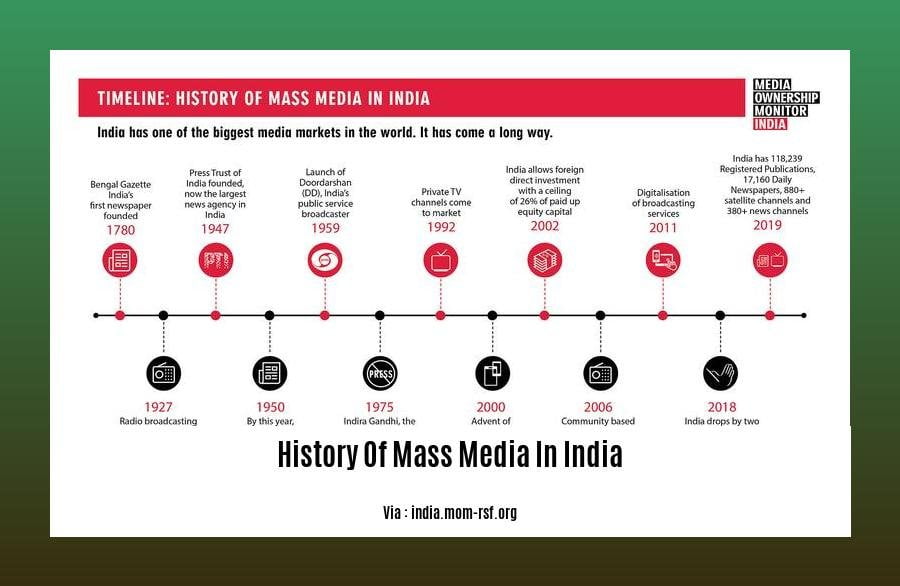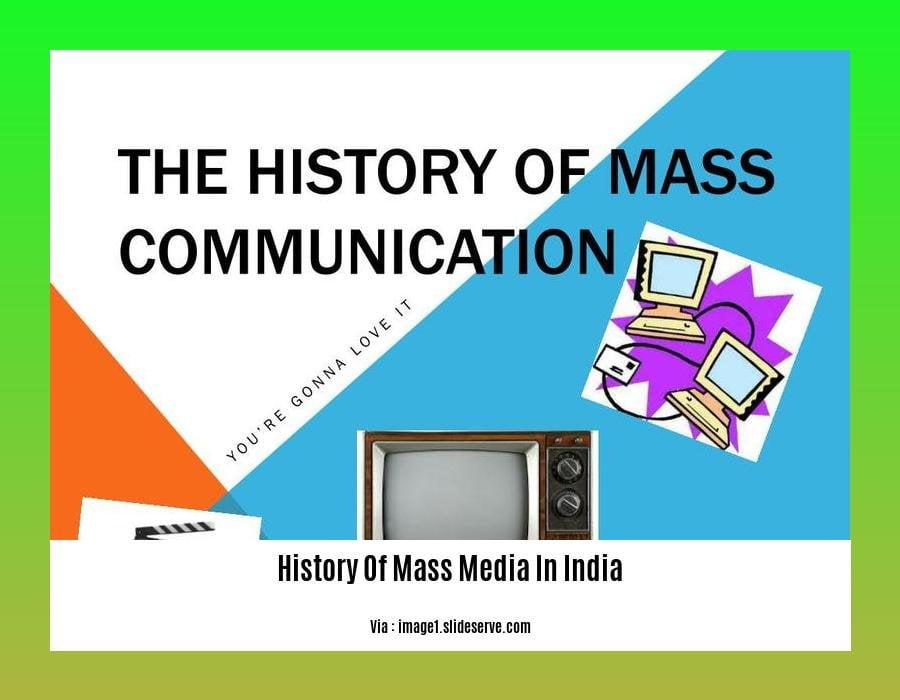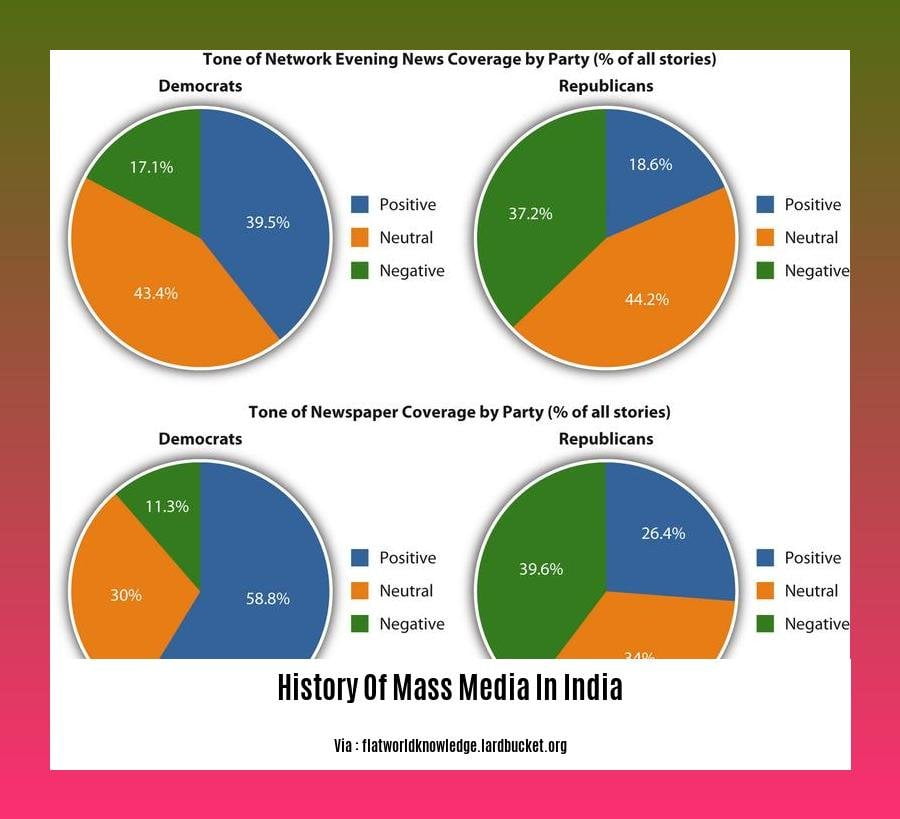Embark on an enthralling journey through the annals of [1. Tracing the Transformation: A Journey Through the History of Mass Media in India]. From the humble beginnings of newspapers and radio to the revolutionary impact of digitalization, this article delves into the captivating evolution of mass media in India. Witness how traditional forms of communication shaped public discourse and influenced pivotal historical events, while the advent of social media platforms ushered in a new era of content creation and engagement. Explore the intricate interplay between technology and content, and discover the profound influence of mass media on India’s cultural, social, and political landscape.
Key Takeaways:
Mass media in India includes television, radio, cinema, newspapers, magazines, and online websites/portals.
Print media in India dates back to 1780 with the publication of Hicky’s Bengal Gazette.
Radio broadcasting began in 1927 and was nationalized in 1930, becoming All India Radio.
The Press Council of India, established in 1978, ensures the freedom and responsibility of the Indian press.
Traditional print and television media are often family-owned and may engage in self-censorship.
New media in India is generally more professional and critical of the government.
**Mass Media in India: A Journey Through Time**


A Glimpse into India’s Media Landscape
The world of mass media in India is a rich tapestry of diverse platforms that have played a pivotal role in shaping the nation’s cultural, social, and political landscape. From the humble beginnings of print journalism to the digital revolution, the history of mass media in India has been a remarkable journey of transformation.
The Early Pioneers of Print Media
The year 1780 marked a significant milestone in India’s media history with the publication of Hicky’s Bengal Gazette, the country’s first newspaper. This pioneering effort laid the foundation for a vibrant print media landscape that would flourish in the years to come.
The Power of Radio
In the 1920s, the airwaves came alive with the introduction of radio broadcasting. All India Radio, established in 1930, became a powerful medium for disseminating information and entertainment across the vast expanse of the Indian subcontinent.
The Birth of Indian Cinema
The early 20th century also witnessed the birth of Indian cinema, which quickly captured the hearts and imaginations of the Indian populace. From the silent era to the advent of “talkies,” Indian films became a powerful medium for storytelling, social commentary, and cultural expression.
The Rise of Television
Television made its grand entrance in India in the mid-20th century, ushering in a new era of visual storytelling and entertainment. Doordarshan, India’s national broadcaster, played a pivotal role in bringing television to the masses, transforming the way Indians consumed news and information.
The Digital Revolution and the Internet
The late 20th and early 21st centuries witnessed the advent of the digital revolution, which brought about a seismic shift in the Indian media landscape. The internet, with its vast and interconnected web of information, opened up new avenues for news dissemination, entertainment, and social interaction.
The Convergence of Technology and Media
In recent years, we have witnessed the convergence of technology and media, leading to the emergence of new and innovative platforms for content creation and consumption. Social media platforms, online streaming services, and mobile technology have revolutionized the way we access and engage with media content.
Looking to understand the legal framework governing media in India? Dive into the comprehensive history of media law in India, tracing its evolution through various eras and exploring its profound impact on the country’s media landscape. history of media law in india
Uncover the rich history of Morocco through an interactive timeline, showcasing the pivotal events, influential figures, and transformative periods that have shaped this remarkable nation. history of morocco timeline
Discover the fascinating history of Mountain Province, a land steeped in cultural heritage, natural wonders, and captivating stories. Explore its intriguing past, from ancient civilizations to modern-day developments, and unravel the unique tapestry that makes this region so captivating. history of mountain province
Role of Mass Media in India
Mass media has played a transformative role in shaping India’s social, cultural, and political landscape. Spanning across diverse mediums like newspapers, radio, cinema, and the internet, mass media in India has evolved drastically, impacting public discourse and shaping historical events.
Print Media: A Legacy of Information Dissemination
The roots of mass media in India can be traced back to the late 18th century with the advent of print media. In 1780, James Augustus Hicky, an Irishman, launched “Hicky’s Bengal Gazette” from Calcutta, marking the beginning of newspaper journalism in India. As the 19th century progressed, newspapers like “The Hindu” and “The Times of India” gained prominence, becoming mouthpieces for the Indian independence movement.
Radio: A Voice for the Nation
Radio broadcasting in India commenced in 1927 with the establishment of the Indian Broadcasting Company. In 1930, it was taken over by the government and renamed All India Radio (AIR). AIR played a crucial role in India’s freedom struggle, broadcasting speeches by Mahatma Gandhi and other leaders, uniting the nation in the fight against colonial rule.
Cinema: A Reflection of Society
The history of cinema in India dates back to the late 19th century with the screening of silent films. The first Indian feature film, “Raja Harishchandra” was released in 1913. Over the decades, Indian cinema, particularly Bollywood, has emerged as a global phenomenon, captivating audiences worldwide with its vibrant storytelling and music.
Internet: A New Era of Media Consumption
The advent of the internet in the late 20th century revolutionized mass media in India. With the proliferation of smartphones and affordable data plans, internet penetration in India has skyrocketed in recent years. Websites, online newspapers, and social media platforms have become increasingly popular sources of information and entertainment, challenging the dominance of traditional media.
Social Media: A Platform for Expression and Engagement
Social media platforms like Facebook, Twitter, and Instagram have become powerful tools for mass communication in India. They have empowered citizens to voice their opinions, share information, and connect with others, transcending geographical and social boundaries. Social media has also played a significant role in shaping public opinion and mobilizing social movements.
Key Takeaways:
Mass media in India encompasses various mediums, including print, radio, cinema, and the internet.
Print media, with its legacy dating back to the 18th century, played a vital role in India’s independence movement.
Radio broadcasting in India, pioneered by All India Radio, served as a powerful tool for disseminating information and fostering national unity.
Indian cinema, particularly Bollywood, has gained global recognition for its captivating storytelling and music.
The internet and social media have revolutionized mass media consumption in India, providing platforms for information sharing, entertainment, and social engagement.
Citations:
Press Council of India Act, 1978
FAQ
Q1: What were the earliest forms of mass media in India?
A1: The earliest forms of mass media in India were print newspapers, which date back to the late 18th century. Radio broadcasting began in the 1920s, and film production started in the late 19th century.
Q2: How did the Press Council of India come into being?
A2: The Press Council of India was established in 1978 as a self-regulatory body for the print media in India. It was set up to ensure the freedom and responsibility of the press and to promote ethical journalism.
Q3: What is the role of mass media in Indian society?
A3: Mass media plays a crucial role in Indian society by informing, educating, and entertaining the public. It also serves as a watchdog, holding the government and other powerful institutions accountable.
Q4: What are the challenges facing the Indian media industry?
A4: The Indian media industry faces several challenges, including government censorship, political interference, and economic pressures. The rise of digital media has also posed new challenges for traditional media organizations.
Q5: What is the future of mass media in India?
A5: The future of mass media in India is expected to be shaped by the continued growth of digital media, the increasing use of mobile devices, and the convergence of technology and content creation.
















